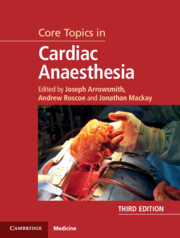Book contents
- Core Topics in Cardiac Anaesthesia
- Core Topics in Cardiac Anaesthesia
- Copyright page
- Dedication
- Contents
- Contributors
- Reviews of the First Edition
- Preface to the Third Edition
- Preface to the First Edition
- Foreword to the First Edition
- Abbreviations
- Section 1 Routine Cardiac Surgery
- Section 2 Anaesthesia for Specific Procedures
- Section 3 Cardiac Catheter Laboratory Procedures
- Section 4 Paediatric Cardiac Surgery
- Section 5 Cardiopulmonary Bypass
- Section 6 Advanced Monitoring
- Section 7 Transoesophageal Echocardiography
- Section 8 Miscellaneous Topics
- Chapter 36 Haematology
- Chapter 37 Cardiac Surgery during Pregnancy
- Chapter 38 Regional Anaesthesia
- Chapter 39 Pain Management after Cardiac Surgery
- Chapter 40 Infection
- Index
- References
Chapter 38 - Regional Anaesthesia
from Section 8 - Miscellaneous Topics
Published online by Cambridge University Press: 12 May 2020
- Core Topics in Cardiac Anaesthesia
- Core Topics in Cardiac Anaesthesia
- Copyright page
- Dedication
- Contents
- Contributors
- Reviews of the First Edition
- Preface to the Third Edition
- Preface to the First Edition
- Foreword to the First Edition
- Abbreviations
- Section 1 Routine Cardiac Surgery
- Section 2 Anaesthesia for Specific Procedures
- Section 3 Cardiac Catheter Laboratory Procedures
- Section 4 Paediatric Cardiac Surgery
- Section 5 Cardiopulmonary Bypass
- Section 6 Advanced Monitoring
- Section 7 Transoesophageal Echocardiography
- Section 8 Miscellaneous Topics
- Chapter 36 Haematology
- Chapter 37 Cardiac Surgery during Pregnancy
- Chapter 38 Regional Anaesthesia
- Chapter 39 Pain Management after Cardiac Surgery
- Chapter 40 Infection
- Index
- References
Summary
Cardiac surgery induces profound sympathetic nervous system and inflammatory responses. This so-called ‘stress response’ to surgery causes a multitude of adverse haemodynamic, metabolic, haematological, endocrine and immunological effects. In the setting of cardiac surgery, the attenuation of pain and sympathetic autonomic activity has many theoretical attractions. The introduction of high-dose opioid techniques into cardiac anaesthesia was based, in part, on the belief that they would inhibit the stress response. Failure to block the stress response completely, combined with equivocal evidence of clinical benefit and the need for prolonged postoperative mechanical ventilation, made the technique unpopular. The demonstration that thoracic sympathetic blockade improves the blood flow in severely diseased coronary arteries, the emergence of less invasive cardiac surgical techniques and economic pressures have prompted renewed interest in regional anaesthetic techniques.
- Type
- Chapter
- Information
- Core Topics in Cardiac Anaesthesia , pp. 274 - 279Publisher: Cambridge University PressPrint publication year: 2020



